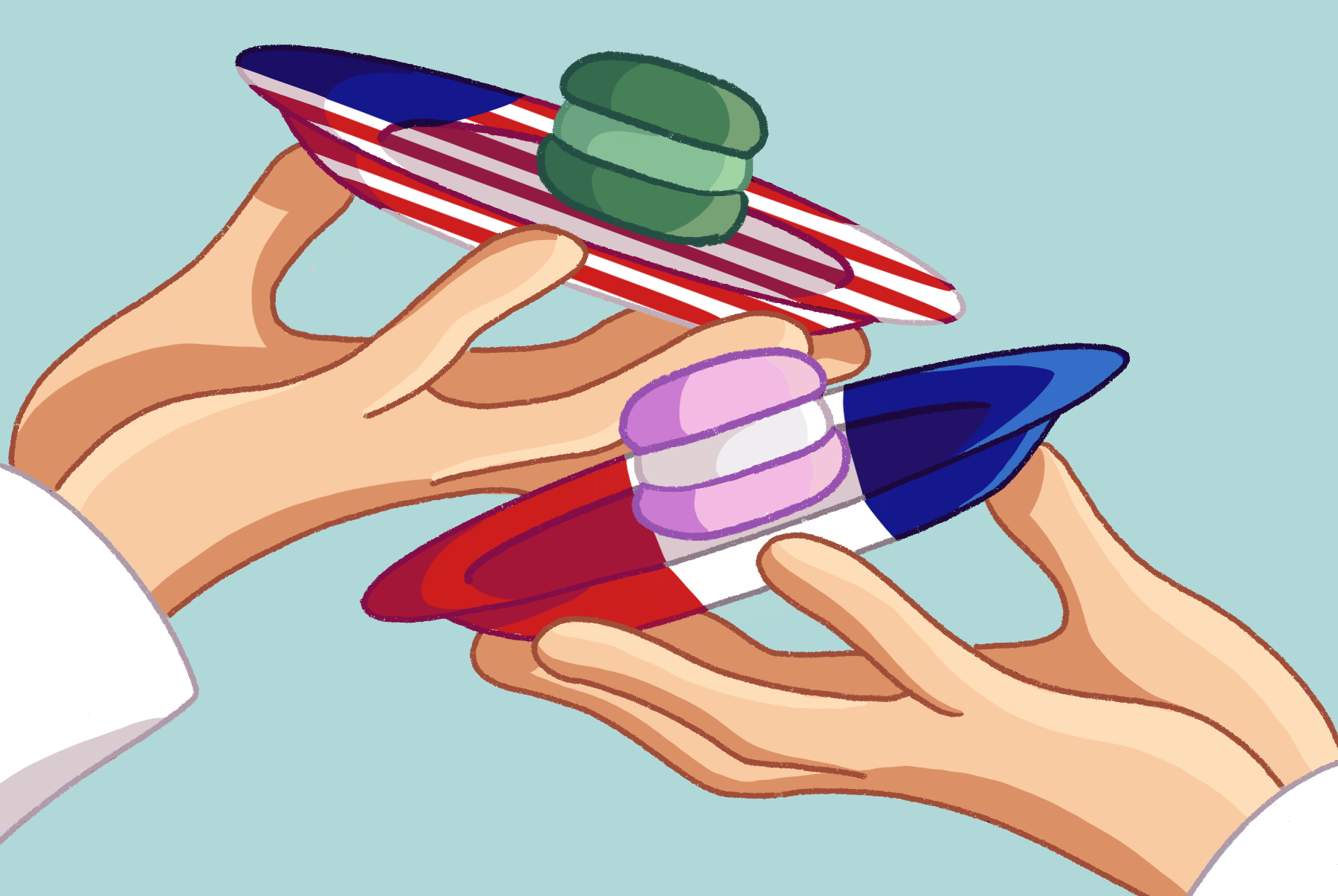Cultural values revolve around the core principles and ideals that societies maintain and perpetuate across generations. The physical aspects of culture, like cuisine, are reflections of these cultural values, and create feelings of identity and belonging. For example, in France, an understanding and appreciation for cuisine is a foundational national value. However, in the United States, the cultural emphasis on capitalism and consumerism leads to the standardization of markets and consumer tastes. As a result, the U.S. places a premium on the monetary, rather than cultural, value of food. In the advent of globalization, “authentic” cuisines are adapted to the cultural contexts of the regions in which they are consumed. Contrasting cultural values in France and in the United States affect the visual presentation of French pastries; the techniques of French pastry chefs working in New York will vary from those of chefs working in Paris.
In Paris, a pâtisserie can be found at nearly every street corner, and typically displays each of the four types of traditional French pastries: shortcrust, choux pastry, puff pastry and confections. Shortcrust is the oldest recorded form of pastry, and was used for savory tarts in the Middle Ages. Shortcrust pastries include tarte citron, tarte framboise and tarte au chocolat. In the 16th century, choux pastry is believed to have been invented by Italian noblewoman Catherine de Medici’s chef, Popelini. Choux pastry has since given rise to a multitude of French classics, like éclairs, croquembouche and the Paris-Brest. Puff pastry originated in Europe in the Middle Ages, but it did not take on its modern form until much later. The croissant was invented in the 17th century in Vienna, and was adapted and perfected by French chefs. It was the perfect accompaniment for New World beverages like tea, coffee and cocoa, solidifying its popularity in France and beyond.
In Paris, there are three types of pâtisseries: traditional, traditional-unique and specialized.
Traditional
Neighborhood pâtisseries are great representations of traditional bakeries. These pastry shops are locally owned and operated, and rarely deviate from the traditional mode of pastry production. These small Parisian pâtisseries share a similar ambiance, and offer the same four basic types of pastries.
Traditional-Unique
The second type of pâtisserie is slightly less common. Traditional-unique pâtisseries offer pastries that fit French expectations and pastries that challenge them. This marriage of tradition and novelty simultaneously resists and respects the cultural norms of French cuisine.
Specialized
The third type of pâtisserie does not carry a variety of traditional pastries, and instead offers one type of specialized pastry. These pastry shops adhere to the French tradition while integrating a technique or flavor profile that is specific to the pâtisserie itself.
Although many of these pâtisseries offer novel products, each uses traditional French techniques and ingredients. Each of the three types of pâtisseries offers at least one of the four categories of pastry, demonstrating consumers’ expectations of quality and standardization. Traditional, traditional-unique and specialized pâtisseries are all rooted in a rich national identity around cuisine that prioritizes tradition and authenticity.
In the United States, specifically in New York City, the three types of pâtisseries do not exist. It’s rare to walk into a “French” patisserie and find the selection you’d expect in Paris. Even bakeries that claim to offer a traditional selection of pastries often lack one or more of the four standard types of pastries, or considerably alter the characteristics of their baked goods. For example, Le Fournil, a French-owned and operated pâtisserie in the Lower East Side of Manhattan, transports the customer to France with a rustic French flag painted on the outside of the shop and long, full display cases of nearly every pastry imaginable. However, Le Fournil offers two types of pastries that would not be found in Paris. Their croissants come in a variety of different flavors, including hazelnut and raspberry, and feature beautiful, colorful lamination. They also offer croissant pretzels, which are twisted into elegant knots and laminated with colors to represent their flavors. These seemingly traditional French pastry shops sprinkle in innovative new techniques that illustrate the commercial necessity of novelty in the United States. Here, a pâtisserie’s survival is contingent upon its ability to continually reinvent the wheel — or rather the croissant.
Dominique Ansel Bakery’s selection exemplifies the tension between tradition and trend in French pâtisseries in the United States. Dominique Ansel offers new flavors of cronuts, or croissant-doughnuts, each month that are seemingly designed for magazines and Instagram posts. Crowds from around the world wind around the city blocks of New York with the hope of tasting these award-winning cronuts.
Traditional French pâtisseries in the United States are not successful because they fail to serve the greater sociocultural needs of consumers. In France, tradition is a deep-rooted value upon which the French built their society and established a national cuisine. The values that make traditional French pâtisseries successful in Paris do not hold the same weight in the United States. These differing value systems require a varied approach to presenting French pastries to the public.
The historical culinary contexts that allow French pâtisseries to exist and flourish in France are not present in the United States. When French chefs move to the U.S., they must adapt to their surroundings. To appease American tastes, each new pastry must be novel, bright and outrageous — forcing the development of hybrid French pastries and wild flavor combinations.
Without the invention of hybrid pastries, French pastry chefs would not survive in the United States because there is no deep culinary foundation upon which pâtisserie could stand. Pâtisseries in the United States rely upon a concept known as staged authenticity, which means products are designed to fit the expectation of the consumer rather than remaining truly authentic. In this case, this means French pastries in New York City are merely reflections of what consumers believe French pastries to be, rather than what French pastries actually are. Dominique Ansel’s pastries are an example of pastries that reflect the traditional techniques of French pâtisserie with major variations in flavor and appearance. Traditional pâtisseries would crumble under the lack of appreciation of French tradition, which is precisely what makes them thrive in France. The values of tradition and a culinary national identity in France create a space for pastries to follow rigid traditional expectations and guidelines. The United States’ emphasis on the values of consumerism and innovation demands that cuisine be flexible enough to bend to the expectations of the American consumer.

















